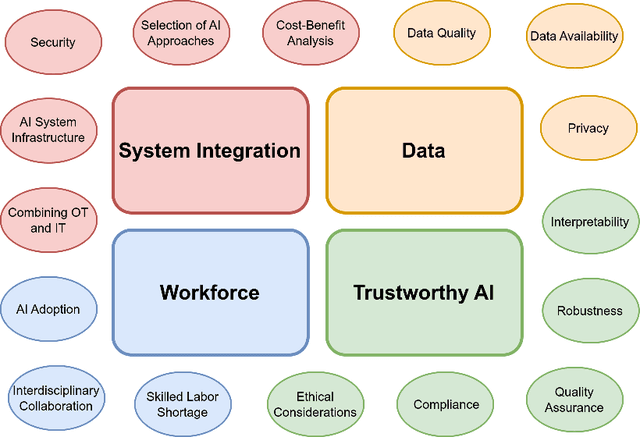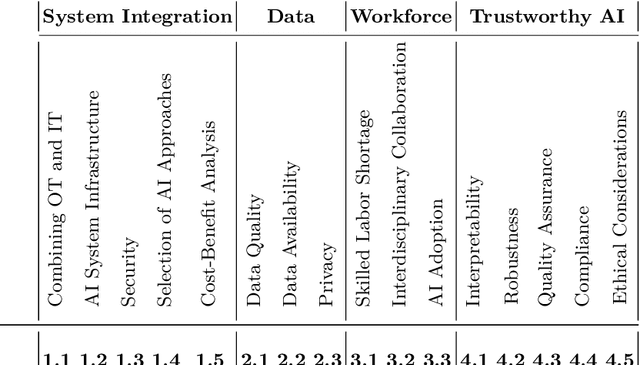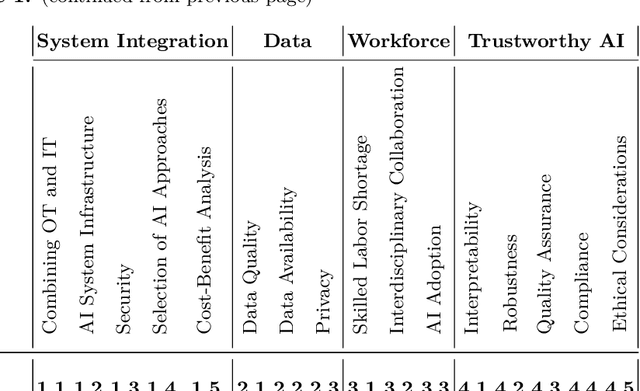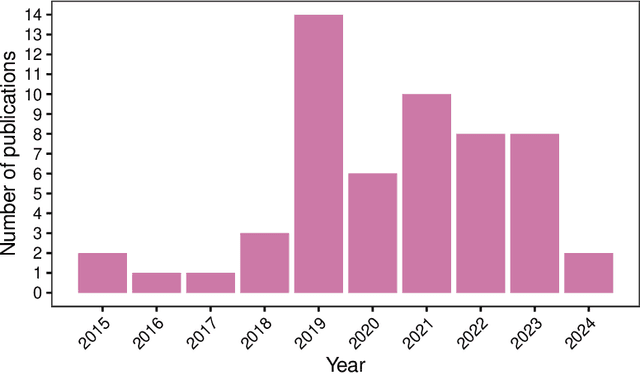Oliver Niggemann
Data Driven Diagnosis for Large Cyber-Physical-Systems with Minimal Prior Information
Jun 12, 2025Abstract:Diagnostic processes for complex cyber-physical systems often require extensive prior knowledge in the form of detailed system models or comprehensive training data. However, obtaining such information poses a significant challenge. To address this issue, we present a new diagnostic approach that operates with minimal prior knowledge, requiring only a basic understanding of subsystem relationships and data from nominal operations. Our method combines a neural network-based symptom generator, which employs subsystem-level anomaly detection, with a new graph diagnosis algorithm that leverages minimal causal relationship information between subsystems-information that is typically available in practice. Our experiments with fully controllable simulated datasets show that our method includes the true causal component in its diagnosis set for 82 p.c. of all cases while effectively reducing the search space in 73 p.c. of the scenarios. Additional tests on the real-world Secure Water Treatment dataset showcase the approach's potential for practical scenarios. Our results thus highlight our approach's potential for practical applications with large and complex cyber-physical systems where limited prior knowledge is available.
Quantifying Robustness: A Benchmarking Framework for Deep Learning Forecasting in Cyber-Physical Systems
Apr 04, 2025



Abstract:Cyber-Physical Systems (CPS) in domains such as manufacturing and energy distribution generate complex time series data crucial for Prognostics and Health Management (PHM). While Deep Learning (DL) methods have demonstrated strong forecasting capabilities, their adoption in industrial CPS remains limited due insufficient robustness. Existing robustness evaluations primarily focus on formal verification or adversarial perturbations, inadequately representing the complexities encountered in real-world CPS scenarios. To address this, we introduce a practical robustness definition grounded in distributional robustness, explicitly tailored to industrial CPS, and propose a systematic framework for robustness evaluation. Our framework simulates realistic disturbances, such as sensor drift, noise and irregular sampling, enabling thorough robustness analyses of forecasting models on real-world CPS datasets. The robustness definition provides a standardized score to quantify and compare model performance across diverse datasets, assisting in informed model selection and architecture design. Through extensive empirical studies evaluating prominent DL architectures (including recurrent, convolutional, attention-based, modular, and structured state-space models) we demonstrate the applicability and effectiveness of our approach. We publicly release our robustness benchmark to encourage further research and reproducibility.
Laplace-Net: Learning Dynamical Systems with External Forcing
Mar 17, 2025Abstract:Modelling forced dynamical systems - where an external input drives the system state - is critical across diverse domains such as engineering, finance, and the natural sciences. In this work, we propose Laplace-Net, a decoupled, solver-free neural framework for learning forced and delay-aware systems. It leverages a Laplace transform-based approach to decompose internal dynamics, external inputs, and initial values into established theoretical concepts, enhancing interpretability. Laplace-Net promotes transferability since the system can be rapidly re-trained or fine-tuned for new forcing signals, providing flexibility in applications ranging from controller adaptation to long-horizon forecasting. Experimental results on eight benchmark datasets - including linear, non-linear, and delayed systems - demonstrate the method's improved accuracy and robustness compared to state-of-the-art approaches, particularly in handling complex and previously unseen inputs.
AAAI Workshop on AI Planning for Cyber-Physical Systems -- CAIPI24
Oct 08, 2024Abstract:The workshop 'AI-based Planning for Cyber-Physical Systems', which took place on February 26, 2024, as part of the 38th Annual AAAI Conference on Artificial Intelligence in Vancouver, Canada, brought together researchers to discuss recent advances in AI planning methods for Cyber-Physical Systems (CPS). CPS pose a major challenge due to their complexity and data-intensive nature, which often exceeds the capabilities of traditional planning algorithms. The workshop highlighted new approaches such as neuro-symbolic architectures, large language models (LLMs), deep reinforcement learning and advances in symbolic planning. These techniques are promising when it comes to managing the complexity of CPS and have potential for real-world applications.
Design Principles for Falsifiable, Replicable and Reproducible Empirical ML Research
May 28, 2024Abstract:Empirical research plays a fundamental role in the machine learning domain. At the heart of impactful empirical research lies the development of clear research hypotheses, which then shape the design of experiments. The execution of experiments must be carried out with precision to ensure reliable results, followed by statistical analysis to interpret these outcomes. This process is key to either supporting or refuting initial hypotheses. Despite its importance, there is a high variability in research practices across the machine learning community and no uniform understanding of quality criteria for empirical research. To address this gap, we propose a model for the empirical research process, accompanied by guidelines to uphold the validity of empirical research. By embracing these recommendations, greater consistency, enhanced reliability and increased impact can be achieved.
Artificial Intelligence in Industry 4.0: A Review of Integration Challenges for Industrial Systems
May 28, 2024



Abstract:In Industry 4.0, Cyber-Physical Systems (CPS) generate vast data sets that can be leveraged by Artificial Intelligence (AI) for applications including predictive maintenance and production planning. However, despite the demonstrated potential of AI, its widespread adoption in sectors like manufacturing remains limited. Our comprehensive review of recent literature, including standards and reports, pinpoints key challenges: system integration, data-related issues, managing workforce-related concerns and ensuring trustworthy AI. A quantitative analysis highlights particular challenges and topics that are important for practitioners but still need to be sufficiently investigated by academics. The paper briefly discusses existing solutions to these challenges and proposes avenues for future research. We hope that this survey serves as a resource for practitioners evaluating the cost-benefit implications of AI in CPS and for researchers aiming to address these urgent challenges.
On the Convergence of Locally Adaptive and Scalable Diffusion-Based Sampling Methods for Deep Bayesian Neural Network Posteriors
Mar 14, 2024Abstract:Achieving robust uncertainty quantification for deep neural networks represents an important requirement in many real-world applications of deep learning such as medical imaging where it is necessary to assess the reliability of a neural network's prediction. Bayesian neural networks are a promising approach for modeling uncertainties in deep neural networks. Unfortunately, generating samples from the posterior distribution of neural networks is a major challenge. One significant advance in that direction would be the incorporation of adaptive step sizes, similar to modern neural network optimizers, into Monte Carlo Markov chain sampling algorithms without significantly increasing computational demand. Over the past years, several papers have introduced sampling algorithms with claims that they achieve this property. However, do they indeed converge to the correct distribution? In this paper, we demonstrate that these methods can have a substantial bias in the distribution they sample, even in the limit of vanishing step sizes and at full batch size.
Position Paper on Materials Design -- A Modern Approach
Dec 18, 2023Abstract:Traditional design cycles for new materials and assemblies have two fundamental drawbacks. The underlying physical relationships are often too complex to be precisely calculated and described. Aside from that, many unknown uncertainties, such as exact manufacturing parameters or materials composition, dominate the real assembly behavior. Machine learning (ML) methods overcome these fundamental limitations through data-driven learning. In addition, modern approaches can specifically increase system knowledge. Representation Learning allows the physical, and if necessary, even symbolic interpretation of the learned solution. In this way, the most complex physical relationships can be considered and quickly described. Furthermore, generative ML approaches can synthesize possible morphologies of the materials based on defined conditions to visualize the effects of uncertainties. This modern approach accelerates the design process for new materials and enables the prediction and interpretation of realistic materials behavior.
Diagnosis driven Anomaly Detection for CPS
Nov 27, 2023



Abstract:In Cyber-Physical Systems (CPS) research, anomaly detection (detecting abnormal behavior) and diagnosis (identifying the underlying root cause) are often treated as distinct, isolated tasks. However, diagnosis algorithms require symptoms, i.e. temporally and spatially isolated anomalies, as input. Thus, anomaly detection and diagnosis must be developed together to provide a holistic solution for diagnosis in CPS. We therefore propose a method for utilizing deep learning-based anomaly detection to generate inputs for Consistency-Based Diagnosis (CBD). We evaluate our approach on a simulated and a real-world CPS dataset, where our model demonstrates strong performance relative to other state-of-the-art models.
Discret2Di -- Deep Learning based Discretization for Model-based Diagnosis
Nov 06, 2023Abstract:Consistency-based diagnosis is an established approach to diagnose technical applications, but suffers from significant modeling efforts, especially for dynamic multi-modal time series. Machine learning seems to be an obvious solution, which becomes less obvious when looking at details: Which notion of consistency can be used? If logical calculi are still to be used, how can dynamic time series be transferred into the discrete world? This paper presents the methodology Discret2Di for automated learning of logical expressions for consistency-based diagnosis. While these logical calculi have advantages by providing a clear notion of consistency, they have the key problem of relying on a discretization of the dynamic system. The solution presented combines machine learning from both the time series and the symbolic domain to automate the learning of logical rules for consistency-based diagnosis.
 Add to Chrome
Add to Chrome Add to Firefox
Add to Firefox Add to Edge
Add to Edge